Overclockable Pentium Anniversary Edition Review: The Intel Pentium G3258
by Ian Cutress on July 14, 2014 10:00 AM EST- Posted in
- CPUs
- Intel
- Pentium
- Overclocking
- Pentium-AE
- G3258
CPU Benchmarks
The dynamics of CPU Turbo modes, both Intel and AMD, can cause concern during environments with a variable threaded workload. There is also an added issue of the motherboard remaining consistent, depending on how the motherboard manufacturer wants to add in their own boosting technologies over the ones that Intel would prefer they used. In order to remain consistent, we implement an OS-level unique high performance mode on all the CPUs we test which should override any motherboard manufacturer performance mode.
HandBrake, SD Film: link
For HandBrake, we take two videos (a 2h20 640x266 DVD rip and a 10min double UHD 3840x4320 animation short) and convert them to x264 format in an MP4 container. Results are given in terms of the frames per second processed, and HandBrake uses as many threads as possible.
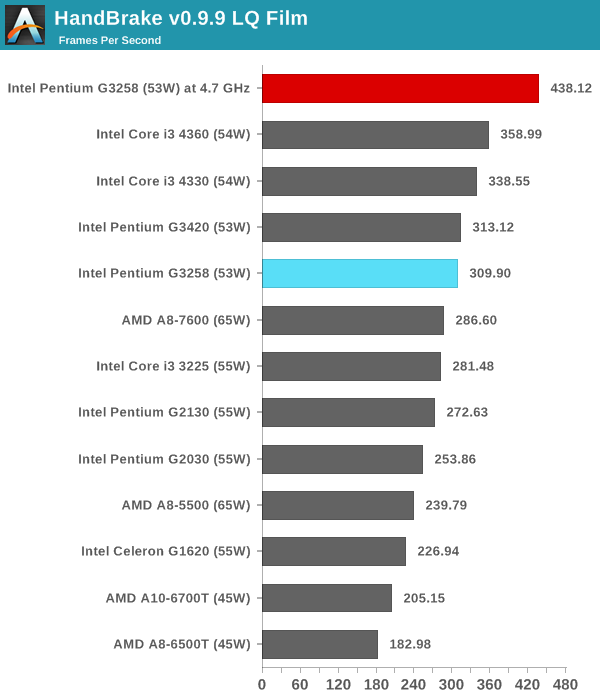
For low quality encoding, single threaded performance wins out over threads despite the extra multi-threading of i3 processors.
HandBrake, 4K60 Animation: link
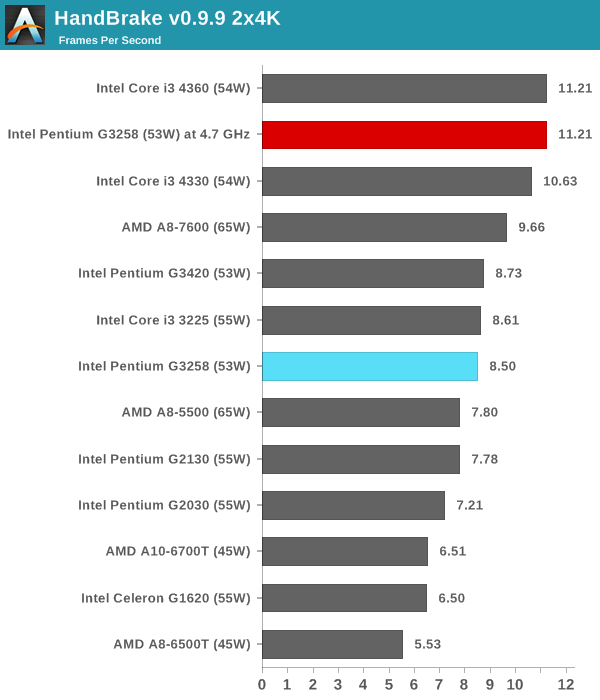
For larger frame sizes, the extra MHz of the overclock brings it on par with the i3-4360, although one might suggest spending the extra $40 for the i3 to ensure full stability.
Agisoft Photoscan – 2D to 3D Image Manipulation: link
Agisoft Photoscan creates 3D models from 2D images, a process which is very computationally expensive. The algorithm is split into four distinct phases, and different phases of the model reconstruction require either fast memory, fast IPC, more cores, or even OpenCL compute devices to hand. Agisoft supplied us with a special version of the software to script the process, where we take 50 images of a stately home and convert it into a medium quality model. This benchmark typically takes around 15-20 minutes on a high end PC on the CPU alone, with GPUs reducing the time.
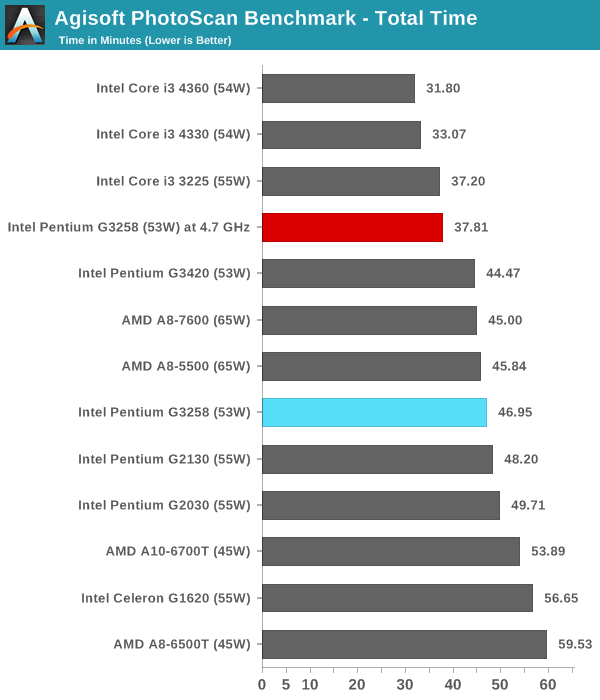
Dolphin Benchmark: link
Many emulators are often bound by single thread CPU performance, and general reports tended to suggest that Haswell provided a significant boost to emulator performance. This benchmark runs a Wii program that raytraces a complex 3D scene inside the Dolphin Wii emulator. Performance on this benchmark is a good proxy of the speed of Dolphin CPU emulation, which is an intensive single core task using most aspects of a CPU. Results are given in minutes, where the Wii itself scores 17.53 minutes.
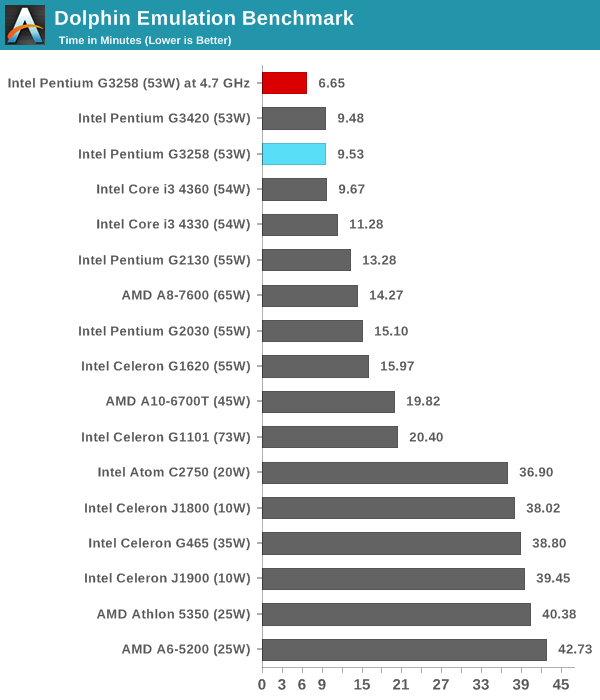
Dolphin is another example where Haswell combined with strong single threaded performance wins.
WinRAR 5.0.1: link
This test compresses a set of 2867 files across 320 folders totaling 1.52 GB in size – 95% of these files are small typical website files, and the rest (90% of the size) are small 30 second 720p videos.
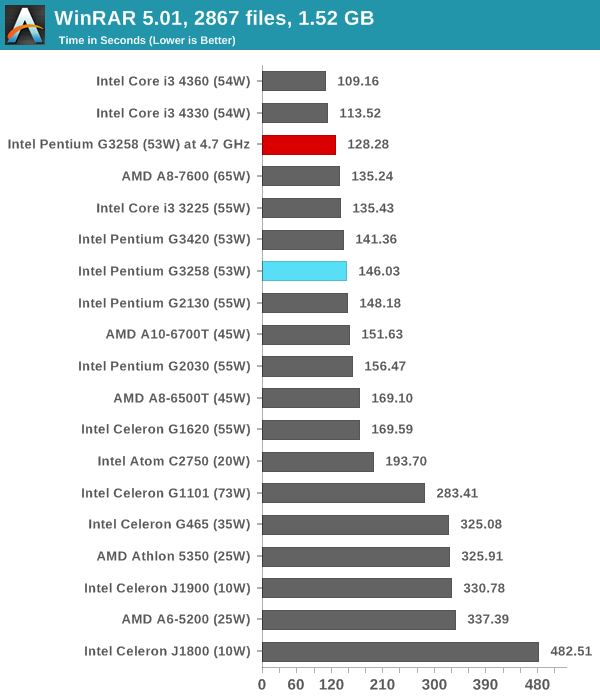
PCMark8 v2 OpenCL on IGP
A new addition to our CPU testing suite is PCMark8 v2, where we test the Work 2.0 and Creative 3.0 suites in OpenCL mode. As this test is new, we have not run it on many AMD systems yet and will do so as soon as we can.
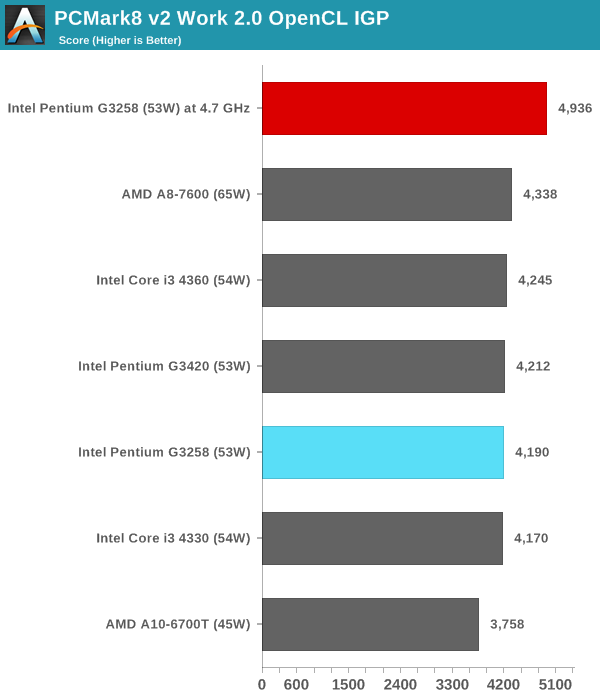
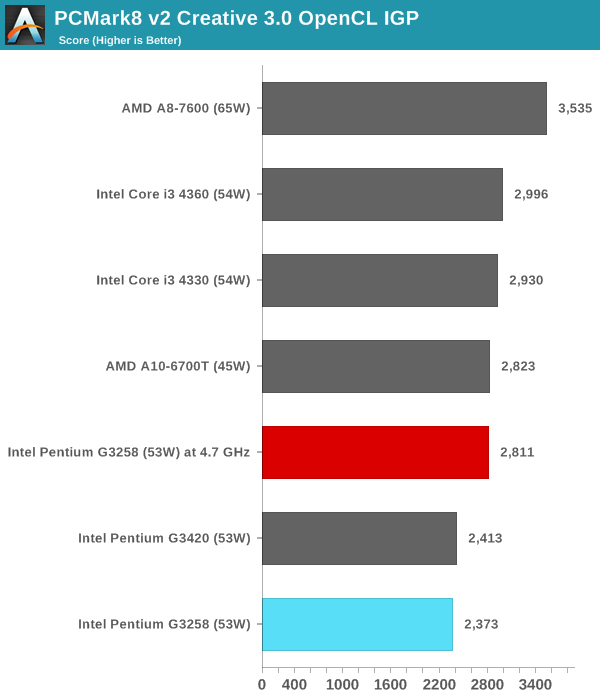
In both of our PCMark8 v2 results, overclocking the CPU gave a significant jump in performance. This would be down to the single threaded nature of parts of the benchmark, allowing web browsing and the snappyness of the system to be sped up.
Hybrid x265
Hybrid is a new benchmark, where we take a 4K 1500 frame video and convert it into an x265 format without audio. Results are given in frames per second.
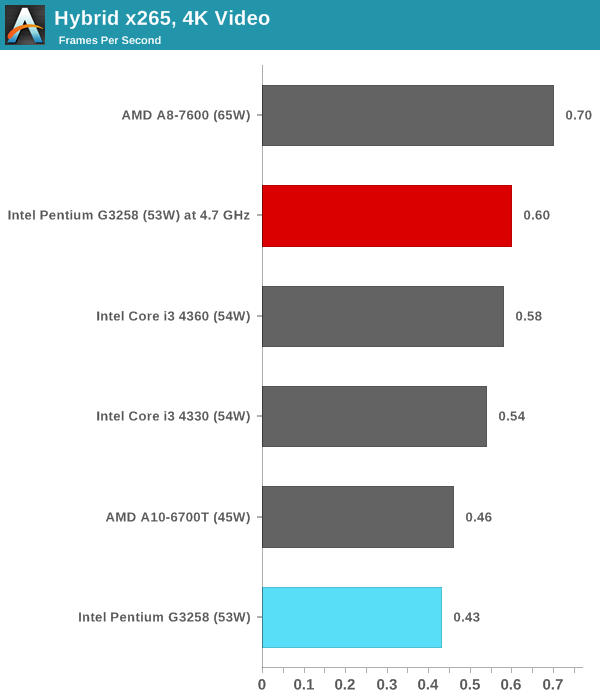
Almost an extra 50% performance for Hybrid x265 encoding.
Cinebench R15
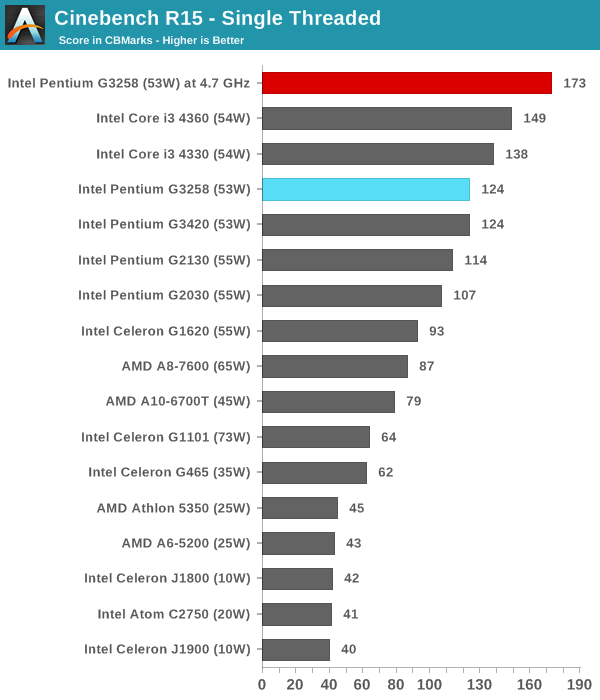
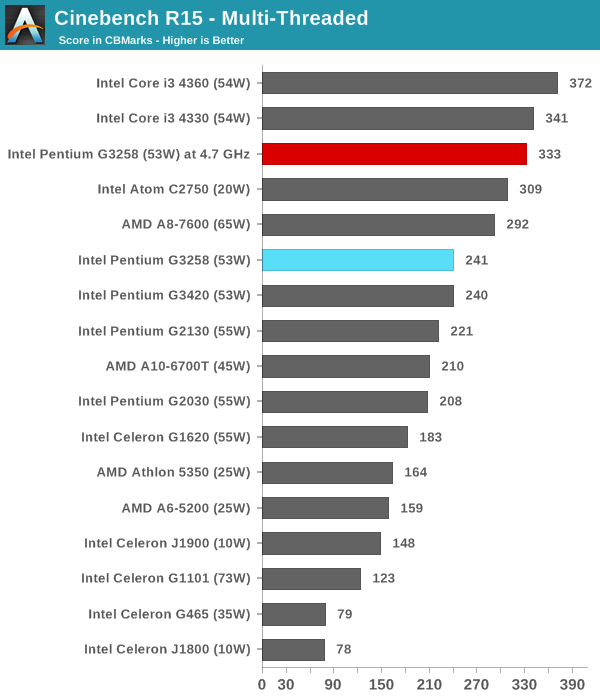
3D Particle Movement
3DPM is a self-penned benchmark, taking basic 3D movement algorithms used in Brownian Motion simulations and testing them for speed. High floating point performance, MHz and IPC wins in the single thread version, whereas the multithread version has to handle the threads and loves more cores.

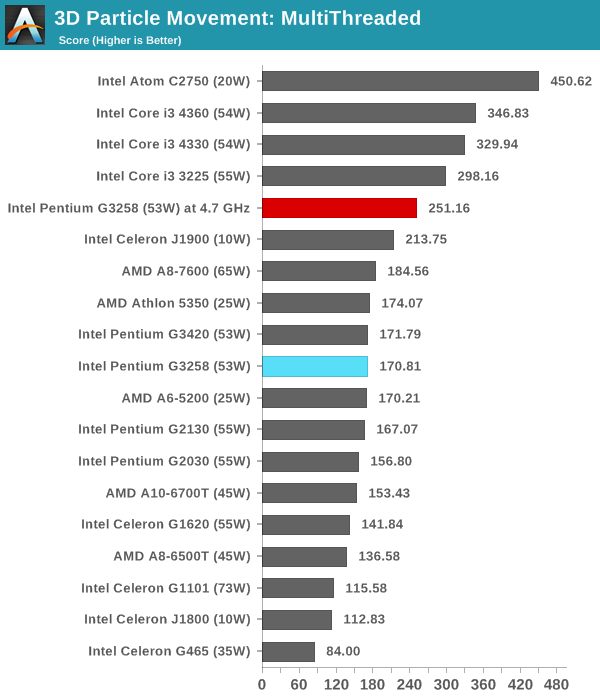
FastStone Image Viewer 4.9
FastStone is the program I use to perform quick or bulk actions on images, such as resizing, adjusting for color and cropping. In our test we take a series of 170 images in various sizes and formats and convert them all into 640x480 .gif files, maintaining the aspect ratio. FastStone does not use multithreading for this test, and results are given in seconds.
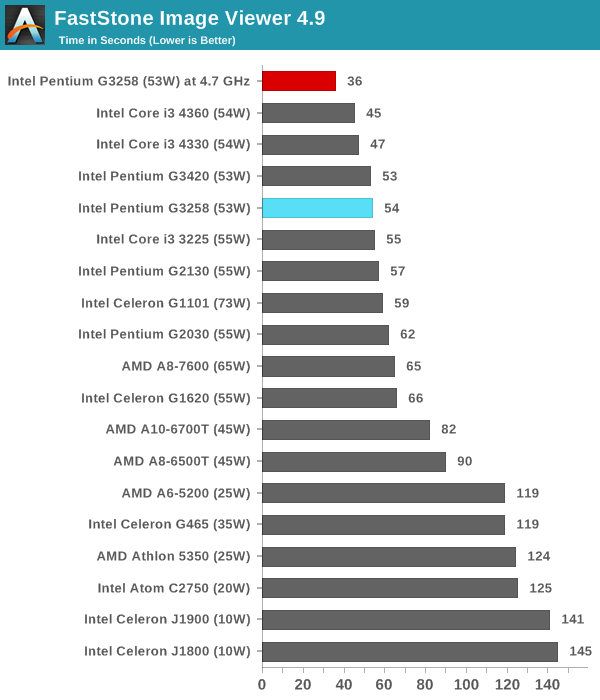
Web Benchmarks
On the lower end processors, general usability is a big factor of experience, especially as we move into the HTML5 era of web browsing. For our web benchmarks, we take four well known tests with Chrome 35 as a consistent browser.
Sunspider 1.0.2
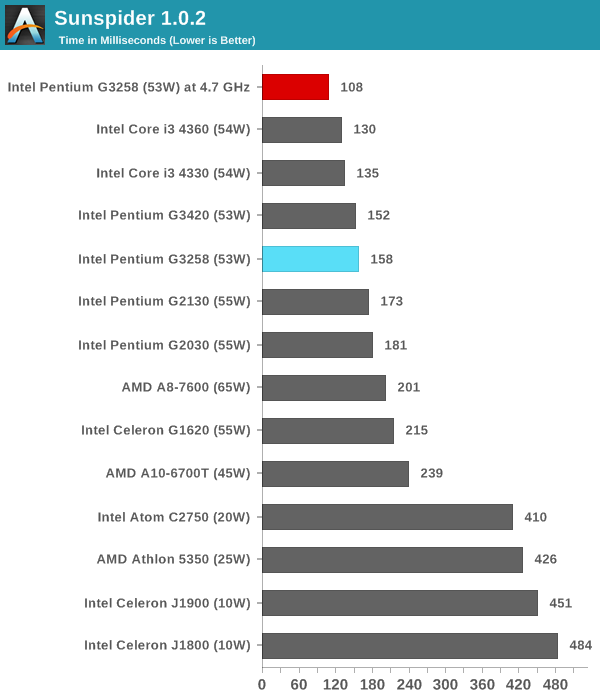
Mozilla Kraken 1.1
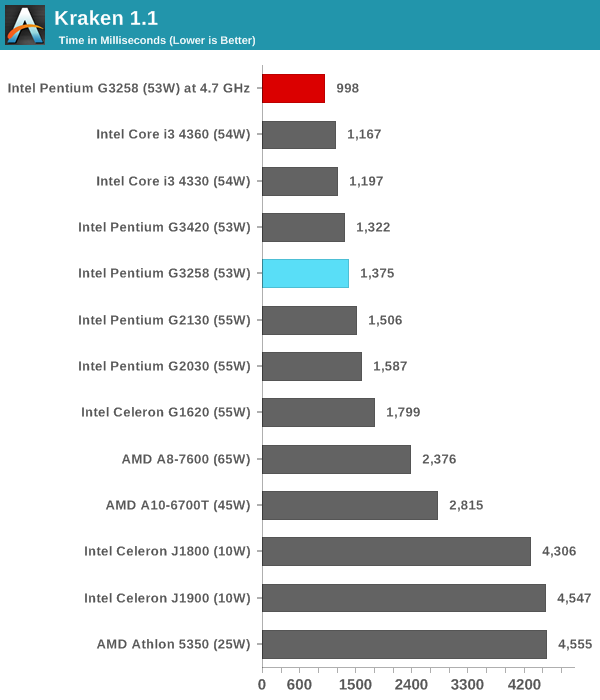
WebXPRT
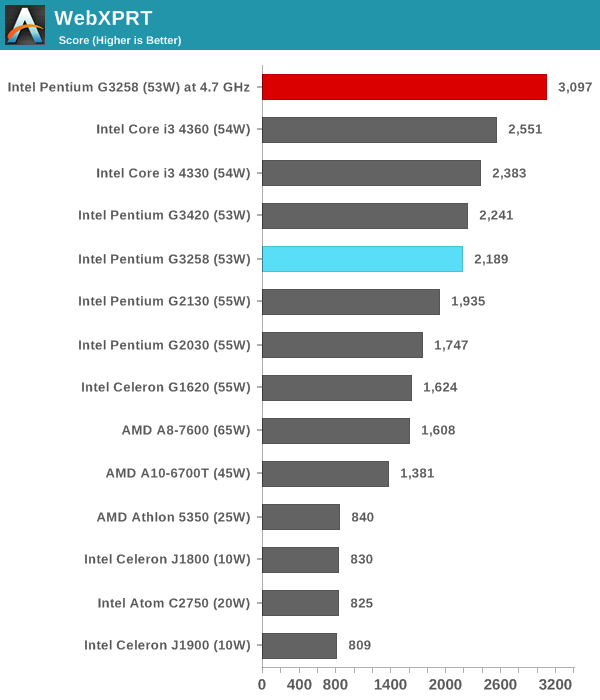
Google Octane v2
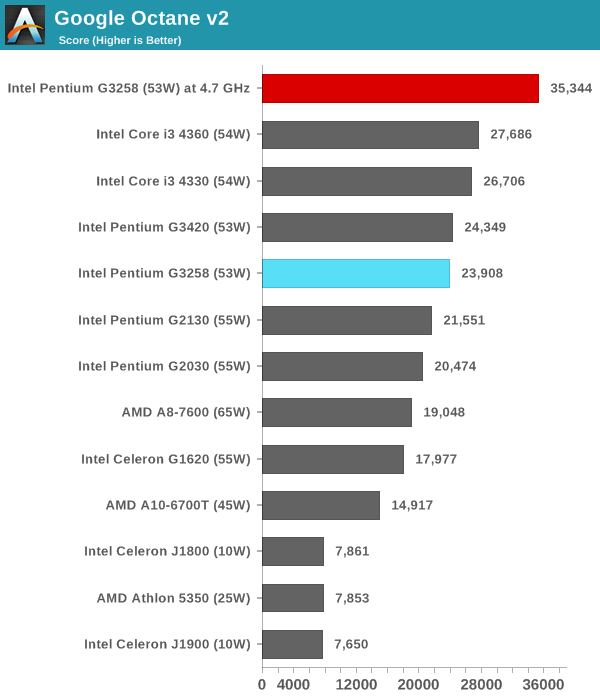
The usage model for an overclocked G3258 comes in highly single threaded environments. 4.7 GHz is nothing to be sniffed at, especially when it comes to web browsing or simple photo editing where it beats out more expensive processors. With multithreaded scenarios, it battles with the i3 depending on if the software can use hyperthreading to its full advantage. If the software can do that, then the i3 still wins out.










96 Comments
View All Comments
smunter6 - Monday, July 14, 2014 - link
And don't forget about Micro Center which has been offering the G3258 for $60 since it came out.HanzNFranzen - Tuesday, July 15, 2014 - link
The i3 4130 is on Newegg at the moment for $112.00 (3.4ghz instead of 3.5ghz of the 4330)Computer Bottleneck - Tuesday, July 15, 2014 - link
The i3-4130 is not just 100 Mhz slower than i3-4330. It is also missing 1MB of cache. (See my comments elsewhere after this article on why that might be important. I posted an Anandtech forum link with some test results to back up my concerns)HangFire - Monday, July 14, 2014 - link
The E2160 was Core 2 architecture, but it wasn't a "Core 2 Duo E2160". It was Pentium-branded with no Level 3 cache and a very small Level 2 cache.I had the E2180 and overclocked the snot out of it for over a year until I ponied up the bucks for a quad core. It could play any game of the time on "High" competently except for some micro-stutters. I attribute that to the lack of a big CPU L2/L3 cache, not to mention the old-style FSB memory interface.
Rankor - Monday, July 14, 2014 - link
"...taking a low cost part, such as the Celeron 300A, and adjusting one or two settings to make it run as fast as a Pentium III 450 MHz."Celery 300A's were based off the Mendocino Pentium II, not the Pentium III Coppermines.
drexnx - Monday, July 14, 2014 - link
the 450mhz p!!! the 300A competed against weren't coppermines though, they were Katmai cores ;)drexnx - Monday, July 14, 2014 - link
and that half-speed off-die L2 cache was a big detriment to the Katmai as well, since the 300A was full speed on-dieHruodgar - Monday, July 14, 2014 - link
Also I could get mine to 504 MHZ :)extide - Tuesday, July 15, 2014 - link
Original 300A had only 128K though, where as the Coppermines had 256K. Some of the later Celerons had no L2, though.Concillian - Monday, July 14, 2014 - link
stock speed i3 beats a massively OC'ed dual core. The multi core scaling era really is here. i3 is cheaper if you consider the whole system (non-OC mobo easily offsets the CPU cost, no need for a massive cooler on a stock clock, etc..) and performs better in almost every scenario...This leads me to one conclusion. Intel is banking on people making a dumb decision and buying this just because it's OCable.
As the article says, an i3-K CPU would be ideal. However, Intel is too smart to release one. They know it will eat into the margins that it's enjoyed by positioning it's offerings so people feel compelled to buy an i5-K or i7-K .